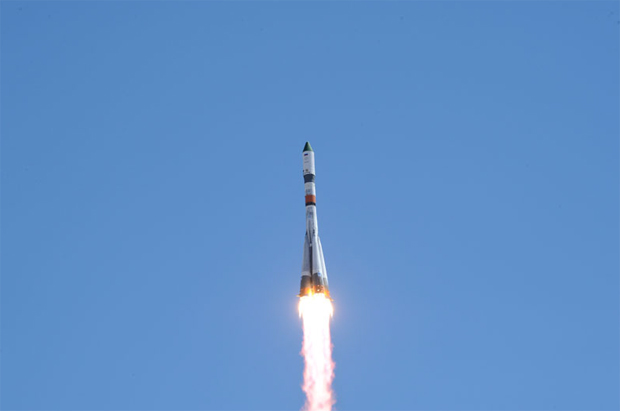Unanswered questions leave ISS crews in holding pattern
Four weeks after a Progress space station supply ship spun out of control in a launch mishap, Russian engineers have not yet revealed what might have gone wrong, casting a cloud of uncertainty over downstream flights of unpiloted cargo ships as well as Soyuz crew ferry craft.
The Progress M-27M/59P cargo craft was launched from the Baikonur Cosmodrome in Kazakhstan on April 28. The ascent appeared to go smoothly but at roughly the moment the supply ship reached orbit, something went wrong, damaging the cargo ship, imparting a rapid spin and boosting the craft to a higher-than-planned altitude.
Despite repeated attempts during passes over Russian ground stations, engineers were never able to regain control of the errant craft and it burned up in the atmosphere above the Pacific Ocean on May 8. It was the second failure in four years for a Progress bound for the International Space Station.
Telemetry apparently did not provide a conclusive indicator of what went wrong with the latest flight and engineers reportedly began focusing on the possible failure of a weld in the liquid oxygen tank of the Soyuz booster's upper stage.
Anatoly Zak, writing on RussianSpaceWeb and quoting unnamed sources in the Russian space industry, said the weld in question had to be re-worked during the tank's fabrication. A failure in flight could have triggered a catastrophic tank rupture and release of propellant that could have damaged the Progress and imparted the rapid spin.
But Zak reported that other engineers concluded the suspect weld was unlikely to fail in such a manner. An alternative theory, he reported, holds that the Progress could have contributed to the failure if separation commands were issued by the spacecraft's flight computer at the wrong time.
Until the failure investigation is complete, the status of the next Progress launch is in doubt as is launch of a Soyuz spacecraft carrying three fresh crew members to the International Space Station.
In the wake of the Progress failure, the Russians delayed the return to Earth of the Soyuz TMA-15M spacecraft carrying outgoing space station commander Terry Virts, European Space Agency astronaut Samantha Cristoforetti and Soyuz commander Anton Shkaplerov. Landing had been planned for May 13 but now is expected around June 11.
Launch of their replacements, Soyuz TMA-17M commander Oleg Kononenko, NASA astronaut Kjell Lindgren and Japanese astronaut Kimiya Yui, was delayed from May 26 to around July 27. But that assumes engineers get to the bottom of the Progress failure and confirm no similar issues with the Soyuz.
Space station planners typically like to minimize the time between the departure of one three-seat Soyuz and the arrival of the next. During that period, only three crew members are aboard the outpost and the time available for research is limited.
Whenever Shkaplerov, Virts and Cristoforetti depart, station commander Scott Kelly, cosmonaut Mikhail Kornienko and Gennady Padalka will have to carry the load until Kononenko and his Soyuz TMA-17M crewmates arrive.
To help clear the way, the Russians said earlier they would launch the next Progress, originally planned for Aug. 6, in late June or early July, after making sure whatever derailed the earlier Progress had been resolved. But it's not yet clear when that launch might be attempted.
The Soyuz delays highlight NASA's dependence on the Russians for crew transportation. The agency is paying for development of new commercial crew capsules being built by Boeing and SpaceX, but earlier funding shortfalls have delayed initial flights to 2017.
On Wednesday, NASA officially ordered its first crew rotation flight from Boeing and said SpaceX would receive a similar order later this year.
In a statement, NASA said orders are placed "two to three years prior to the missions to provide time for each company to manufacture and assemble the launch vehicle and spacecraft."
NASA requested $1.24 billion for the commercial crew program in its fiscal 2016 budget request, but another funding shortfall appears likely. It's not yet clear what impact that might have on eventual launch dates, but NASA said in its statement that without full funding the agency "will have to delay future milestones for both partners proportionally and extend sole reliance on Russia for crew access to the station."
The current Russian launch disruption comes during a particularly busy period aboard the space station as NASA works to reconfigure the lab complex to enable dockings by the Boeing and SpaceX crew capsules.
Earlier this year, multiple spacewalks were carried out to install wiring and antennas needed by new docking mechanisms and navigation gear that will be used by approaching and departing crew ships.
On Wednesday, flight controllers at the Johnson Space Center in Houston remotely operated the station's robot arm to move a storage compartment from the Earth-facing port of the central Unity module to the forward port of the Tranquility compartment. The move freed up Unity for future U.S. cargo ship dockings. Cargo ships also use the Earth-facing port of the forward Harmony module.
On June 26, SpaceX plans to launch its seventh station supply mission, carrying up the first of two new international docking adapters, or IDAs, needed by the commercial crew ships. The first IDA will be attached to a pressurized mating adapter on the front end of Harmony where space shuttles used to dock.
This fall, a spare pressurized mating adapter will be moved from the Tranquility module to the forward Harmony compartment and attached to its upper space-facing port. The second IDA, scheduled for launch late this year, then will be attached to the upper PMA.
Four spacewalks will be required along the way to route power and data to the PMAs and docking adapters.
When all the work is done, the station will have two U.S. crew docking ports that can be used by Boeing and SpaceX and two NASA-managed cargo ports that will be used to berth supply ships launched by SpaceX, Orbital Sciences Corp. and the Japanese space agency.

